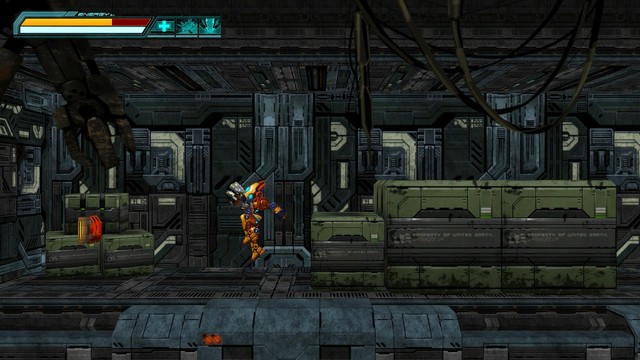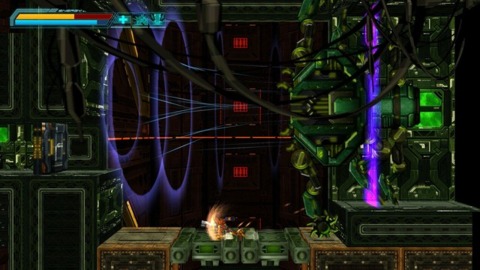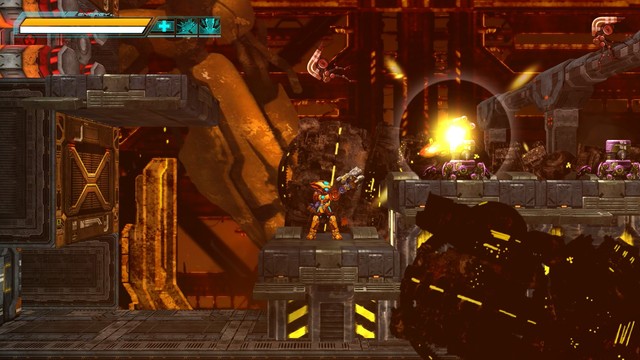A.R.E.S. Extinction Agenda EX tells the story of Ares and Tarus, two robots who are working together to save humans from annihilation at the hands of an evil robot mastermind named Zytron. The metallic heroes must infiltrate a space station and avoid succumbing to a nasty virus if they want to take down their foe and guarantee a peaceful existence for humankind. Their mission isn't an easy one.
If you have played through a few of the Mega Man X games, you might recognize most of those narrative elements. The similarities don't stop with the basic premise, though. Bold character portraits and detailed sprites and environments resemble the memorable designs seen in Capcom's once-popular action series, and the rocking soundtrack wouldn't feel out of place in a new installment in that same franchise. The developers at Origo Games are clearly paying homage, and they mostly do a decent job of it.

The suitably bare-bones plot unfolds over the course of seven chapters that consist of a single platforming stage apiece. Many of those areas are lengthy, requiring 8 to 10 minutes to clear even when you know what you're doing. There technically are two separate campaigns, one for each of the starring robots, but you see the same stages in the same order no matter which story you're advancing. Those areas all contain three hidden upgrade chips, and there is an ample supply of data chips. Your performance in each stage is tracked, and you are rated based on factors such as the number of items found, the damage dealt, the difficulty setting, and the speed with which you cleared an area. Leaderboards also let you compare your running point total to the totals of friends and strangers around the world.
Most of the above features seem to have been designed to encourage you to get lots of use out of the meager selection of individual stages. The best reason to spend more than an hour or two going through a campaign, though, is that things get downright difficult on the normal and hardcore settings unless you upgrade your chosen hero at every available opportunity. That means spending time blasting robot enemies for credits that you can spend on improvements, which require upgrade chips. Many of those chips are well hidden, so you may have to play through a stage several times just to find everything.

As you might expect from a platformer of this sort, some of the upgrade chips you need most taunt you from behind barriers you can't pass, or from perches high atop ledges that initially are out of your reach. Your robots start their respective campaigns without a lot of mobility and firepower, but you can eventually learn to hover or perform useful air dashes (depending on the character), and there are four main weapons that can also be upgraded to turn Ares and Tarus into capable killing machines. Though you may be tempted to advance through numerous stages without bothering to backtrack, such an approach is ill-advised. It leads to unnecessary frustration because unless you search for upgrade chips and earn lots of credits, you'll face later stages without movement enhancements that greatly increase your ability to survive tricky jumps.
Jumping poses a recurring problem until you have cleared most of the game because there are numerous gauntlets that demand precise timing. For instance, one area finds you leaping along a series of platforms hanging over a pit, while rubbish periodically pours from openings overhead and flying enemies roam free. In another area, you must ascend a vertical shaft while a monstrous machine chases you, and that potentially thrilling moment becomes a chore because jumps take longer than they should, and a single misstep means you're probably headed back to the checkpoint at the base of the shaft. There are several other such moments, but at least checkpoint placement is generous enough that you seldom have to backtrack too far if things do go wrong. There's also an unlimited supply of lives, so those occasional moments of trial-and-error gameplay don't damage the overall experience as much as they otherwise could have.
Though the jumping leaves something to be desired, the developers made up for that shortcoming and others by ensuring that the stages switch things up frequently. There are mild puzzle elements, such as when you must activate switches and then quickly dash through an opening. There also is a good selection of boss and sub-boss robots. Most such foes use a variety of attacks, so you need to fight them a few times to memorize patterns and learn what techniques work best. None of what you see along the way feels much different from anything that you have done hundreds of times before in similar games, but the feeling here is that you're working your way through a highlights reel instead of just a generic selection of bland corridors.

Interestingly, the game also improves as it gets easier. Negotiating a challenging series of platforms or getting in one last shot that destroys a boss just before he can do the same to you is satisfying, but the greater thrill comes from completely mastering those formerly difficult moments and returning with heavier firepower and greater speed to exact sweet revenge. The game does a good job of facilitating such moments, which is one reason it works as well as it does.
A.R.E.S. Extinction Agenda EX features only seven stages, and a skilled player can likely work through either of the two available campaigns in only a couple of hours. There is more to do besides, but the game ultimately doesn't offer much longevity. It's a capable homage to a beloved 16-bit franchise, complete with attractive visuals and great audio, but the overall package is best suited to those who are eager for new challenges to keep them busy after they've worked through the readily available and more affordable library of older fare that already covered the same ground.